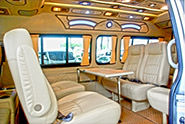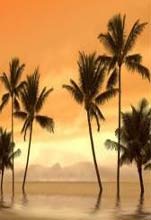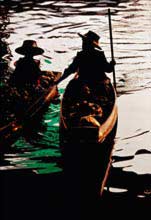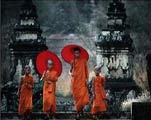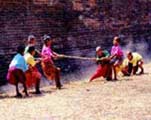|
The Mon are the earliest known inhabitants of lower
Burma. They founded an empire, and introduced both
writing and Buddhism into Burma.
In the year 573, two Mon brothers, Prince Samala
and Prince Wimala, founded the Mon kingdom Hongsavatoi
at the present site of modern Pegu. This kingdom
flourished in peace and prosperity for several
centuries until it was occupied by the Burman dynasty.
In 1757, the Burma ruler U Aungzeya invaded and
devastated the Mon kingdom, killing tens of thousands
of Mon, including learned Mon priests, pregnant
women, and children. Over 3,000 priests were massacred
by the victorious Burmans in the capital city alone.
Thousands more priests were killed in the countryside.
The surviving priests fled to Thailand, and Burman
priests took over the monasteries. Most of the
Mon literature, written on palm leaves, was destroyed
by the Burmans. Use of the Mon language was forbidden,
and Burman became the medium of instruction.
Mon people were persecuted, oppressed, and enslaved,
and countless people were burned in holocausts,
like the Jews before the Nazis. Mon properties
and possessions were looted and burned throughout
Burma. Mons fled further south into Burma's Tenasserim
Division and east into Thailand.
Unfortunately, the oppression of the Mon people
has persisted to the present day.
Burma has been racked by civil war ever since its
independence, over 40 years ago. The Mon people,
as well as other ethnic minorities such as the
Karen and Shan, have suffered greatly during this
period.
Burma gained independence from Britain in 1948,
and it has been ruled by military dictators since
then. The current rulers are the SLORC (State Law
and Order Restoration Council), who took power
in a 1988 coup, suspending the legislature and
the judiciary.
One of the most notorious actions of the military
regime in Burma was the Aug. 8, 1988 massacre of
thousands of students engaged in peaceful protests
against the government. Follow this link for photos
from the 1988 massacre.
The current Burmese government has received world-wide
condemnation for its human-rights violations, and
Daw Aung San Suu Kyi, a Burmese political prisoner,
received the 1991 Nobel Peace Prize for her efforts
to bring international attention to the grave conditions
in Burma. Following this link for more information
on Aung San Suu Kyi.
The U.S. State Department, in its 1994 report on
human rights in Burma, wrote
Despite an appearance of greater normalcy fostered
by increased economic activity, in fact the Government's
unacceptable record on human rights changed little
in 1994. Out of sight of most visitors, Burmese
citizens continued to live subject at any time
and without appeal to the arbitrary and sometimes
brutal dictates of the military. There continued
to be credible reports, particularly from ethnic
minority-dominated areas, that soldiers committed
serious human rights abuses, including extrajudicial
killings and rape. The use of porters by the army--with
all the attendant maltreatment, illness, and even
death for those compelled to serve--remained a
standard practice and probably even increased.
The Burmese military forced hundreds of thousands,
if not millions, of ordinary Burmese (including
women and children) to "contribute" their
labor, often under harsh working conditions, to
construction projects throughout the country. The
forced resettlement of civilians also continued.
Burma is shared by many nationalities, and it is
necessary to find a national framework that includes
full partnership for all the people of the country.
If not, civil war cannot be stopped, and the dream
of building the union of Burma as a developed and
democratic country cannot be realized. The Indigenous
Mon Council of Burma fears that Burma will become
another Bosnia unless the military Junta shares
authority with the Burmese ethnic minorities.
|

